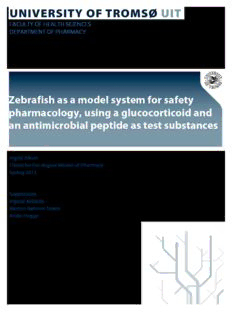
Zebrafish as a model system for safety pharmacology, using a glucocorticoid and an antimicrobial ... PDF
Preview Zebrafish as a model system for safety pharmacology, using a glucocorticoid and an antimicrobial ...
FACULTY OF HEALTH SCIENCES DEPARTMENT OF PHARMACY Zebrafish as a model system for safety pharmacology, using a glucocorticoid and an antimicrobial peptide as test substances Ingrid Albert Thesis for the degree Master of Pharmacy Spring 2013 Supervisors: Ingvild Mikkola Morten Bøhmer Strøm Beate Hegge FACULTY OF HEALTH SCIENCES DEPARTMENT OF PHARMACY Zebrafish as a model system for safety pharmacology, using a glucocorticoid and an antimicrobial peptide as test substances Ingrid Albert Thesis for the degree Master of Pharmacy Spring 2013 Supervisors: Ingvild Mikkola Morten Bøhmer Strøm Beate Hegge ACKNOWLEDGEMENTS This project was carried out at the Pharmacology research group, Department of Pharmacy, University of Tromsø from October 2012 trough May 2013. There are several people who have greatly helped me along the way, and whom I would like to thank. First of all, to my main supervisor Ingvild Mikkola, thanks for having been available to share your knowledge through useful discussions during the course of the year, and for much appreciated advice from start until the very end of the writing process. Thanks to the Natural Product and Medicinal Chemistry research group, Department of Pharmacy, University of Tromsø, led by Morten B. Strøm, for providing one of the test compounds used in this project. Thanks especially to Dominik Ausbacher for being committed to the project and helping me interpret results. Also, thanks for your time spent preparing the embryos for electron microscopy. It turned out really great in the end! Beate Hegge, thanks for all your help with mating and handling the zebrafish. Special thanks to Rune Hogseth for always being available to give a helping hand in the lab or answer questions. Thanks to my family for general support and for providing me with dinners when I had no time to cook for myself. Also, thanks for proofreading and valuable writing tips. To Helge, thanks for supporting and putting up with me. Although we have been far away from each other this year, you have still been there for me all the way. Last but not least, I would like to thank Lillann for being my partner in crime this year, and for all the nice coffee breaks. I feel we have managed to keep each other more or less sane throughout this process, even at times when life as a master student was not at its best. Thank you for that! May 2013, Ingrid Albert I II SUMMARY The zebrafish is an exciting model organism with a lot to offer and many possible areas of application. Toxicity assays using zebrafish embryos are becoming increasingly popular with the pharmaceutical industry as a tool to bridge the gap between conventional cell based screens and animal testing. The main aim of this project was to explore the zebrafish as a model system for use in safety pharmacology, and to look into some of the different methods that can be used to do so. Dexamethasone and a novel antimicrobial drug lead were tested for toxicity in the zebrafish embryo by visual assessment of mortality and malformations, and by performance of apoptosis assay and western blotting to look at apoptosis and proliferation. Treatment with relative low concentrations of dexamethasone caused a significant increase in embryo malformation rate, while staining with acridine orange revealed altered apoptotic activity in brain tissues and in the urogenital tract of treated embryos. The antimicrobial peptide, 2,2-amino acid derivative 161, showed generally low toxicity to zebrafish embryos, as measured by the LC estimated in this project, compared to previously reported MIC and 50 IC values for the drug against multi-resistant bacterial strains and cancer cells. However, 50 truncation of tail and damage to tail tissue were seen after treatment with the drug. Staining with acridine orange showed increased apoptotic activity in brain tissues and the urogenital tract of treated embryos. Western blots of whole embryo extracts of embryos treated with either drug gave conflicting result, and a refinement of the method is suggested for future experiments. In parallel with the zebrafish experiments, studies using mammalian cell cultures were carried out. Both excess glucocorticoids and decreased levels of the transcription factor PAX6 have been associated with development of cataract and glaucoma. Glucocorticoids and PAX6 also influences glioblastoma cancer patient prognosis. We wanted to explore if treatment with dexamethasone would influence expression levels of PAX6 in human lens epithelial cells and human glioblastoma cells. We were also interested in looking at proliferation and apoptosis in these cell lines following dexamethasone treatment. To investigate this, western blots were done. However, results were inconclusive, and further studies are needed to answer this. III IV ABBREVIATIONS ADME Absorption, distribution, metabolism, excretion AMP Antimicrobial peptide BrdU Bromodeoxyuridine Dex Dexamethasone DMEM Dulbecco´s modified eagles medium DTT Dithiothreitol EC Effective concentration FCS Fetal calf serum FE-SEM Field emission scanning electron microscope GBM Glioblastoma multiforme GC Glucocorticoid GR Glucocorticoid receptor Hpf Hours post fertilization IC Inhibitory concentration IHC Immunohistochemistry IOP Intraocular pressure ISH In situ hybridization LC Lethal concentration LD Lethal dose MEM Minimum essential medium eagle MIC Minimum inhibitory concentration MRSA Methicillin-resistant S. aureus MRSE Methicillin-resistant S. epidermis NEAA Non-essential amino acids PBS Phosphate buffered saline PH3 Phospho-histone H3 PTU N-Phenylthiourea qPCR Quantitative real-time polymerase chain reaction RBC Red blood cells SDS Sodium dodecyl sulfate SGK Serum- and glucocorticoid-inducible kinase TUNEL Terminal deoxynucleotidyl transferase-mediated dUTP nick end-labeling V VI
Description: